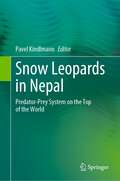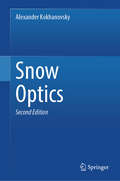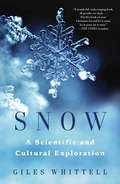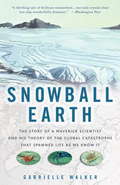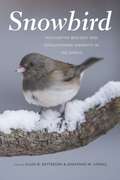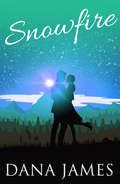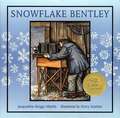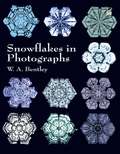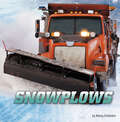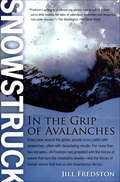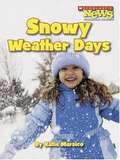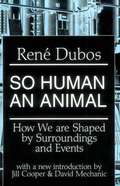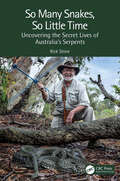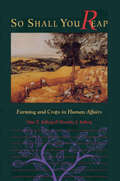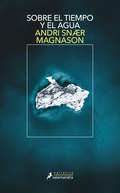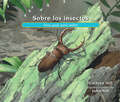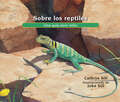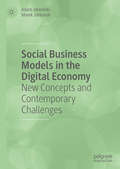- Table View
- List View
Snow Leopards in Nepal: Predator-Prey System on the Top of the World
by Pavel KindlmannSnow leopard (Panthera uncia) is an endangered species, and its population size is steadily declining. The main threats to the snow leopard include illegal trade, conflict with locals (human-snow leopard conflict), lack of conservation, awareness and policy, and climate change. To avoid its extinction, we badly need a good knowledge of its ecology, distribution and population dynamics, including interactions with its prey, which will take into account various scenarios of changes in climate and human impact on snow leopard. This book aims to put together a considerable amount of unpublished data collected by the co-author of most of the chapters, Bikram Shrestha, which might be useful for other researchers working on snow leopard. In addition, researchers might find it useful to have a key for determining the diet of snow leopard based on remnants of its food in its scats. Last, but not least, based on the difficulty we experienced trying to compare and combine different sets of results, we propose a general methodology for collecting data. Thus, this book is not an all-encompassing compendium, but an attempt to fill some gaps in the literature and to show, how to publish new data on snow leopard in a useful and workable way. The first part, describing the main features of snow leopard and its main prey ecology, is followed by a comprehensive review of data available on its abundance and threats to its survival. The third, most extensive part—the substance of the book—presents new data from 15 years of intensive camera trapping combined with scat sampling. These data are analyzed by means of advances GIS and genetic techniques, which yields a large amount of conservation implications.The purpose of this book is to provide a tool for both environmental managers and researchers to find quickly what is known about this species for conservation planning and for an effective protection of snow leopard. However, enthusiasts interested in wild cats may welcome the book, too.
Snow Optics
by Alexander KokhanovskyThis book is the first book of its kind, focusing exclusively on the optical properties of snow. As a complex and turbid medium, snow is approached as a strongly light-scattering (in the visible spectrum) medium with large, nonspherical ice grains. The book discusses both experimental and theoretical results, as well as the remote sensing of snow using ground-based, airborne and satellite optical instrumentation. The book will be of particular importance for researchers studying snow characteristics (the size of grains, snow pollution and albedo) using various remote-sensing techniques.
Snow: A Scientific and Cultural Exploration
by Giles WhittellBrimming with interesting facts and surprising anecdotes, this scientific and cultural history opens our eyes to the wonders of one of nature&’s most delicate, delightful, and deadly phenomena: SNOW! Perfect for fans of The Hidden Life of Trees and Rain.Go on an extraordinary journey across centuries and continents to experience the wonders of snow; from the prehistoric humans that trekked and even skied across it tens of thousands of years ago to the multi-billion-dollar industry behind our moving, making, and playing with snow. Blending accessible writing with fascinating science, Giles Whittell explores how snow dictates where we live, provides us with drinking water, and has influenced countless works of art and more. Whittell also uncovers compelling mysteries of this miraculous substance, such as why avalanches happen, how snow saved a British prime minister&’s life, where the legend of the yeti comes from, and the terrifying truth behind the opening ceremony of the 1960 winter Olympics. Filled with in-depth research and whip-smart prose, Snow is an eye-opening and charming book that illuminates one of the most magnificent wonders of nature.
Snow: The biography
by Giles Whittell**The Financial Times' Travel Book of the Year 2018** How many snowflakes does it take to build a snowman? Where is the snowiest place on Earth? When will the last snowflake fall? Snow has a lot in common with religion. It comes from heaven. It changes everything. It creates an alternative reality and brings on irrational behaviour in humans. But unlike most religions, snow has never had a bible, until now. Giles Whittell, a passionate snow enthusiast, takes the reader on a quest through centuries and continents to reveal the wonders of snow. Along the way he uncovers the mysteries of snow crystal morphology, why avalanches happen, how snow saved a British prime minister’s life, and the terrifying truth about the opening ceremony of the 1960 winter Olympics. The Secret Life of Snow is the next best thing to a white Christmas, an anthropology and travelogue for everyone from ski addicts to the millions of people who have never even seen it.
Snowball Earth: The Story of the Great Global Catastrophe That Spawned Life as We Know It
by Gabrielle WalkerWalker (contributing editor), who has a doctorate in natural sciences from Cambridge U., UK, has written a lively account of Harvard geologist Paul Hoffman's theories of the origins of life on earth that he believes followed its complete freezing over. Writing for the popular reader, Walker explains the geology in lay terms, and it is the details of Hoffman's travels to remote and often frozen areas that move the narrative. Annotation (c)2003 Book News, Inc., Portland, OR (booknews.com)
Snowbird: Integrative Biology and Evolutionary Diversity in the Junco
by Ellen D. Ketterson Jonathan W. AtwellAt birdfeeders and in backyards across North America, the dark-eyed junco, or snowbird, can be found foraging for its next meal. With an estimated population of at least 630 million, juncos inhabit forests, parks, and even suburban habitats, making them one of the continent’s most abundant and easily observable songbirds. But while common and widespread, juncos also exhibit extraordinary diversity in color, shape, size, and behavior across their range, making them ideal study subjects for biologists interested in ecology and evolutionary diversification. Intended for scholars, citizen scientists, and amateur ornithologists, alike, Snowbird synthesizes decades of research from the diverse and talented researchers who study the Junco genus. Though contributors approach their subject from a variety of perspectives, they share a common goal: elucidating the organismal and evolutionary processes by which animals adapt and diversify in response to environmental change. Placing special emphasis on the important role that underlying physiological, hormonal, and behavioral mechanisms play in these processes, Snowbird not only provides a definitive exploration of the junco’s evolutionary history and behavioral and physiological diversity but also underscores the junco’s continued importance as a model organism in a time of rapid global climate change. By merging often disparate biological fields, Snowbird offers biologists across disciplines an integrative framework for further research into adaptation, population divergence, and the formation of new species.
Snowfire
by Dana JamesWhen Beth married glaciologist Allan Bryce she believed nothing would ever come between them. But something did – another wife. Without waiting for explanations Beth fled, burying herself in work and determined to replace her shattered memories of their love with award-winning photographs. Two years on, meeting unexpectedly on an expedition in Iceland, Beth can't understand why his eyes are as cold as the landscape and his fury so bitter – for she had done nothing wrong.
Snowflake Bentley
by Jacqueline Briggs Martin<P>Snow in Vermont is as common as dirt. Why would anyone want to photograph it? <P>But from the time he was a small boy, Wilson Bentley thinks of the icy crystals as small miracles, and he determines that one day his camera will capture for others their extraordinary beauty. <P>Often misunderstood in his time, Wilson Bentley took pictures that even today reveal two important truths about snowflakes: first, that no two are alike, and second, that each one is startlingly beautiful. <P>His story, gracefully told by Jacqueline Briggs Martin and brought to life in Mary Azarian's lovely woodcuts, gives children insight into a soul who had not only a scientist's vision and perseverance, but a clear passion for the wonders of nature.
Snowflake Bentley
by Jacqueline Briggs MartinIn this Caldecott Medal–winning picture book, the true story of Wilson Bentley and his singular fascination with snowflakes is rendered in rich prose and gorgeous artwork, perfect for the holidays, snow days, and everyday.Wilson Bentley was always fascinated by snow. In childhood and adulthood, he saw each tiny crystal of a snowflake as a little miracle and wanted to understand them.His parents supported his curiosity and saved until they could give him his own camera and microscope. At the time, his enthusiasm was misunderstood. But with patience and determination, Wilson catalogued hundreds of snowflake photographs, gave slideshows of his findings and, when he was 66, published a book of his photos. His work became the basis for all we know about beautiful, unique snowflakes today. This biographical tribute to a very special farmer is the perfect holiday gift or snow day read.
Snowflakes in Photographs
by W. A. BentleyRemarkable revelations of nature's diversity, revealed in hundreds of snowflake images taken by American photographer Bentley during a 50-year period. Over 850 illustrations of snow crystals, with no two designs exactly alike, will inspire artists, designers, and craftspeople in search of extraordinary patterns for textiles, wallpaper, and other creative projects.
Snowplows (Wild About Wheels)
by Nancy DickmannWhoosh! Snow flies into the air as a snowplow pushes it out of the way. These big machines help keep drivers safe. Besides moving snow, they can put sand and salt on roads to make them safer. Young readers will learn about the main parts of snowplows, how they work, and where these important vehicles are used.
Snowstruck: In the Grip of Avalanches
by Jill FredstonEvery year around the globe, people cross paths with avalanches-some massive, some no deeper than a pizza box-often with deadly results. Avalanche expert Jill Fredston stalks these so-called freaks of nature, forecasting where and when they will strike, deliberately triggering them with explosives, teaching potential victims how to stay alive, and leading rescue efforts when tragedy strikes. Having spent decades trying to keep avalanches and people apart, Fredston brings them together unforgettably in Snowstruck. From a rare store of personal experience, she conveys a panorama of perspectives: a skier making what may prove his final decision, a victim buried so tightly that he can't move a finger, rescuers racing both time and weather, forecasters treading the line between reasonable risk and danger. Seamlessly interweaving these accounts, Fredston brings to life the awesome forces of nature that can turn the mountains deadly-and the equally inexorable forces of human nature that lure us time and again into treacherous terrain.
Snowy Owl Scientist (Scientists in the Field)
by Mark WilsonAre the snowy owls in trouble? Venture into the Alaskan arctic and the summer realm of these predator birds to find out. Discover the diverse species necessary to owl survival, how climate change is affecting the landscape of their nesting site of past millennia, and what it takes to do field research in this action-packed addition to the award-winning Scientists in the Field series.It's July on Alaska's North Slope, and scientist Denver Holt is in Utqiagvik surveying nests. Denver has been coming here since 1992, and the snowy owls he studies have been coming here much longer: thousands of years.With its mix of coastal, low-elevation tundra and a rich presence of lemmings, the North Slope is the only area in Alaska where snowy owls regularly nest. How do snowy owls decide where they will nest? How do they manage to arrive at locations where food will be abundant? What drives the success of these delicate tundra ecosystems? These are the mysteries Denver is trying to solve to help ensure a bright future for these elegant hunters.
Snowy Weather Days (Scholastic News Nonfiction Readers)
by Katie MarsicoExplains what snow is and describes what is done with it when it falls on the ground.
So Human an Animal: How We Are Shaped by Surroundings and Events
by René DubosIn this collection of stories, the bizarre is rendered normal, the absurd hilarious and the incredible comprehensible. The re-imaginations of reality feature evocations of historical figures, over-televised game show hosts and late-night comedians.<P><P> Pulitzer Prize Winner
So Many Snakes, So Little Time: Uncovering the Secret Lives of Australia’s Serpents
by Rick ShineSnakes are creatures of mystery, arousing fear in many people but fascination in a few. Recent research has transformed our understanding of the behaviour and ecology of these animals, revealed their important roles in diverse ecosystems, and discovered new and effective ways to conserve their populations and to promote coexistence between snakes and people. One of the leading contributors to that scientific revolution has been Prof Rick Shine. Based in Australia, whose snake fauna is diverse and often dangerous, his experiences and anecdotes will inspire a new generation of serpent scientists. Spellbinding stories highlight the challenges, frustrations, and joys of discovery, and give the reader a greater appreciation of these often-slandered slithering reptiles.Key Features Documents the important role played by a preeminent herpetologist. Focuses on research conducted in Australia, especially on snakes. Summarizes highly influential conservation studies. Explores the ways in which research has deepened our understanding of snakes.
So Shall You Reap: Farming And Crops In Human Affairs
by Otto Solbrig Dorothy J. SolbrigSo Shall You Reap is a broad-gauged exploration of the intersections of farming and history. Beginning with the prehistorical era, Otto and Dorothy Solbrig describe the evolution of farming. When and how did people learn to irrigate, to fertilize, to rotate their crops -- and why? Along with its fundamental importance to history, farming has radically altered the physical world. Natural landscapes have been completely transformed to provide room for growth on a large scale of a few species of plants and even fewer species of domesticated animals. Agriculture has altered the earth's biosphere and changed its geosphere: The soil has been modified, forests have been felled, swamps have been drained, rivers have been dammed and diverted. So Shall You Reap presents a fresh and informed perspective on how farming and the crops we grow have changed us and our environment. By understanding the nature of the origins and evolution of agriculture, we will be better prepared to anticipate what the future may hold in store, and what must be done to increase food production while minimizing environmental problems.
Sobre el tiempo y el agua
by Andri Snaer MagnasonUn libro para comprender el futuro del planeta si no actuamos de inmediato. Sobre el tiempo y el agua es un ensayo narrativo profundo y convincente sobre la crisis medioambiental global y, a la vez, una íntima y desesperada súplica al mundo. Nació de una conversación con un científico puntero convencido de que son los escritores, y no los científicos, los más capacitados para hablar de uno de los asuntos más apremiantes para la humanidad. Los argumentos que esgrime son, pues, indistintamente mitológicos o científicos, anecdóticos o estrictamente morales y filosóficos. El resultado es un rico entramado de relatos de viaje, historias familiares, momentos poéticos: un libro bellísimo, a la vez que urgente.
Sobre los insectos: Una guía para niños (About. . .)
by Cathryn SillThis beginner's guide to insects is a must-have for bug-obsessed young learners as well as for those who are simply curious about these creatures. In this Spanish-language addition to the acclaimed About... series, author and educator Cathryn Sill uses simple, easy-to-understand language to teach children what insects are, how they look, how they move, what they eat, and where they live. With beautifully detailed, realistic paintings, noted wildlife illustrator John Sill introduces readers to a wide variety of insects, from ants and beetles to grasshoppers and the monarch butterfly. An afterword provides further details, inspiring young readers to learn more.
Sobre los mamíferos: Una guía para niños (About. . .)
by Cathryn SillAn award-winning first glimpse into the diverse natural world of mammals--now in Spanish.This addition to the acclaimed About... series explains to children in simple, easy-to-understand language what mammals are, what they eat, and where they live. Beautifully detailed, realistic paintings by wildlife illustrator John Sill introduce readers to the huge variety of mammals, from the tiny white-footed deermouse to the large American bison. An afterword provides more details about the animals featured in the book. Parents and pre-school and primary-grade teachers will find this an attractive choice for introducing kids to mammals.
Sobre los pájaros: Una guía para niños (About. . .)
by Cathryn SillAn award-winning, educator-approved first book on birds--now in Spanish.In this simple volume, educator and author Cathryn Sill uses clear, easy-to-understand language to teach children what birds are, what they do, and how they live. Noted wildlife illustrator John Sill provides beautifully detailed, realistic paintings to showcase the birds' diverse and natural worlds, and an afterword provides more details about each bird and inspires further learning.
Sobre los reptiles: Una guía para niños (About. . .)
by Cathryn SillGot a fan of snakes, lizards, and turtles? Dig into this beginner's guide to reptiles from Cathryn and John Sill, creators of the award-winning About... series.Author and educator Cathryn Sill explains in simple language the basic characteristics that all reptiles share, while offering a look at many of the animals that fall into this diverse category, including ever-popular lizards, snakes, and turtles. The beautifully detailed paintings of noted wildlife illustrator John Sill depict reptiles in their habitats and highlight their unique aspects. An afterword provides more detail on each reptile, inspiring further learning.
Social Banks and the Future of Sustainable Finance (Routledge International Studies In Money And Banking Ser. #64)
by Olaf Weber Sven RemerSocial Banking describes a way of value-driven banking that has a positive social and ecological impact at its heart, as well as its own economic sustainability. Although it has a long and successful history, it has arguably never been more topical than it is now in the aftermath of the latest financial crisis. Most Social Banks came out of this crisis not only unscathed but much stronger and bigger than they were before. And contrary to their conventional peers, none of the Social Banks had to be bailed out with public funds. This increasingly attracts the interest not only of clients searching for safe and sensible ways to deposit their funds but also of conventional banks that begin to understand the potential of a more socially oriented approach towards banking. Social Banks and the Future of Sustainable Finance is the first book to deliver a comprehensive and detailed overview about the past, present and possible future of Social and Sustainable Banking for researchers, students and a professional audience. The authors are experts from research and practice and have bee involved in Social Banking for many years. Thus they combine state-of-the-art expertise with valuable insider knowledge. The book covers the following topics: the history of Social Banking, the need for Social Banking in the current economy, the particular issues of managing a Social Bank as business enterprise, Social Banking products and services, the special role of donations and foundations for financing change, the opportunities and challenges for Social Banks lying ahead, and concrete directions for the future of Social Banking. In addition to these respective analyses are many real-world examples and interviews with representatives of Social Banks. As such, this comprehensive collection delivers valuable insights for academics, students and professionals who are interested in the growing field of Social Banking.
Social Business Models in the Digital Economy: New Concepts and Contemporary Challenges
by Adam Jabłoński Marek JabłońskiFilling a gap in the current literature, this book addresses the social approach to the design and use of innovative business models in the digital economy. It focuses on three areas that are of increasing importance to businesses and industry today: social issues and sustainability; digitization; and new economic business models, specifically the sharing and circular economies. The authors aim to solve current scientific concerns around the conceptualization and operationalization of social business models, addressing management intentions and the impact of these models on society. Based on observation of social phenomena and the authors' research and practical experience, the book highlights best practices for designing and assessing social business models.
Social Capital and Urban Networks of Trust
by Jouni HäkliThis is the first book on social capital and trust informed by a critical geographical perspective. The authors examine the role of social capital in the constitution and reproduction of urban networks of trust in different places and contexts. They explore how social capital and trust are reflected in the capacity of these networks to achieve their goals and to deliver specific forms of urban development in a number of Finnish and Italian cities. Finland and Italy present, in many ways, two almost paradigmatic cases of how social capital and trust can work in extremely different and yet very effective ways in the production of the urban. They are two almost ideal laboratories for experimenting new definitions and new understandings of the concepts in question.
